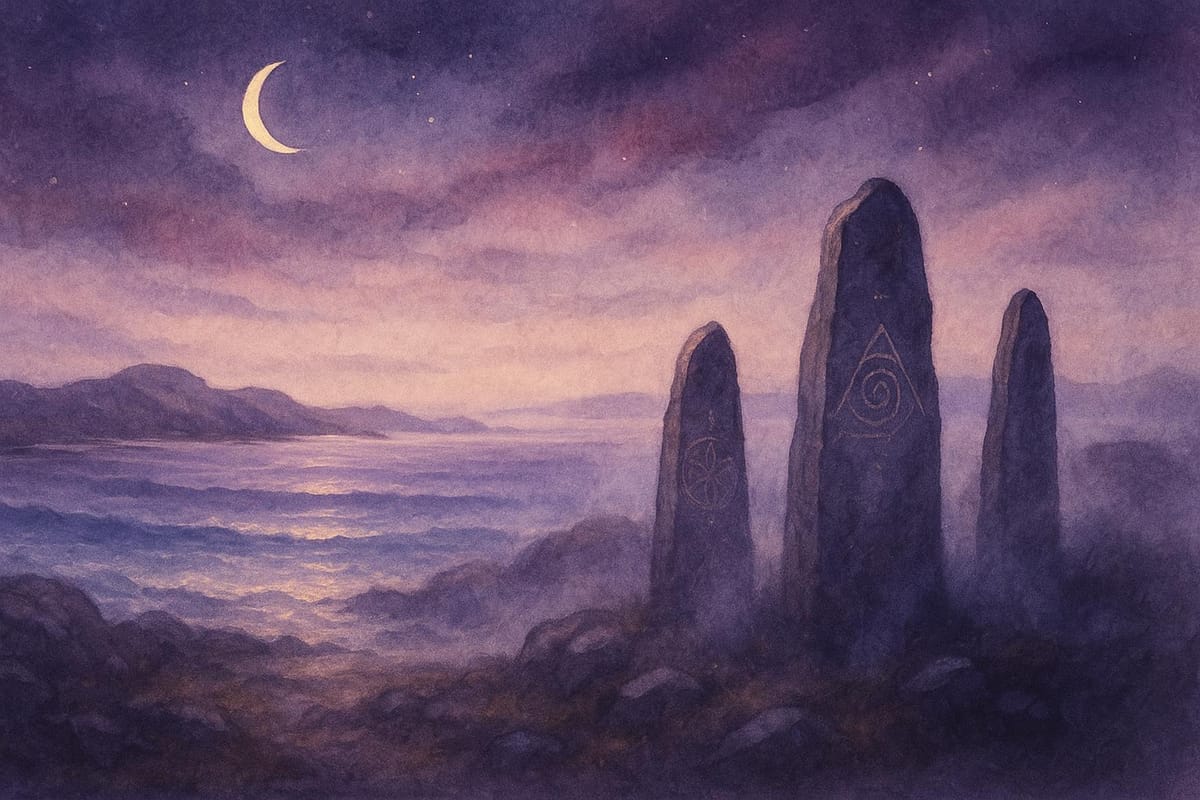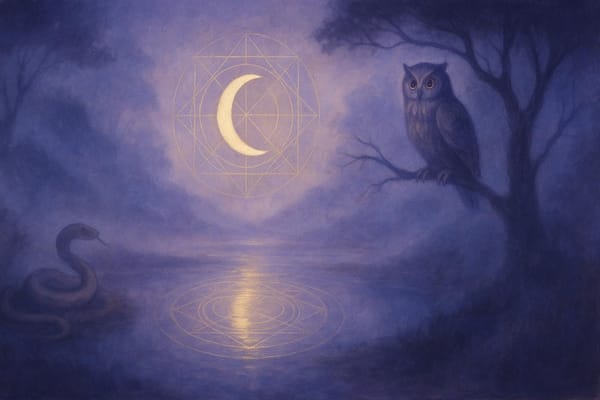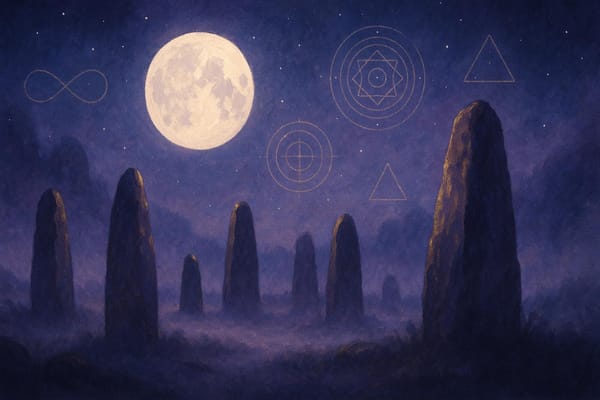Iona: The Veil Is Thin Where the Sea Sings the Soul
Explore the sacred isle where ancient rocks and rich spiritual history create a unique atmosphere of peace and connection to the divine.

Iona is a tiny island in Scotland known as a 'thin place' - where the physical and spiritual worlds feel deeply connected. This sacred island, just 1.5 miles wide and 3 miles long, holds over 1,400 years of spiritual history and draws 130,000 visitors annually.
It’s famous for its ancient monastery founded by St. Columba in 563 AD, burial grounds for 60 kings, and breathtaking landscapes of ancient rocks and serene shores.
Key Highlights:
- Sacred History: Once a Druidic site, Iona became the cradle of Christianity in Scotland.
- Natural Beauty: Features 2-billion-year-old Lewisian Gneiss rocks, pink granite, and green marble.
- Spiritual Energy: Known for its calming atmosphere and "thin" veil between material and spiritual realms.
- Top Spots to Visit: St. Columba’s Abbey, St. Oran’s Chapel, and Dun I for panoramic views.
- How to Get There: A combination of train, ferry, and bus from Oban leads to this serene destination.
Whether you visit for its history, natural beauty, or spiritual peace, Iona offers a unique escape from the modern world.
Iona. Isle of Spirit and Faith. The Holy Island of Scotland. A Personal Pilgrimage June 2022
Physical Features of Iona
Iona may be small, but its landscape holds a captivating blend of natural beauty and spiritual significance that leaves a lasting impression on visitors.
Ancient Rock Formations
The island’s foundation is built on Lewisian Gneiss, a bedrock that spans nearly three-quarters of Iona and dates back over 2 billion years.
This ancient rock, devoid of fossils, is complemented by a striking variety of natural elements like pink granite from the Ross of Mull, green marble, smooth white quartz shaped by the ocean, and serpentine greenstones. Together, they create a landscape that feels both timeless and otherworldly.
Sandra McKay Stewart beautifully captures this unique essence:
"I believe that the ancient crystalline nature of the rocks of Iona contributes immeasurably to the special and unique feelings of joy, peace, rejuvenation, and wonderment that emanate across the island."
The crystalline structure of these rocks is said to hold and release energies, adding to the island's mystical allure.
Waters and Sound
The waters surrounding Iona play a key role in its ethereal atmosphere. The meeting of sea and shore produces natural acoustics that many describe as deeply moving. Liz Budd Ellmann reflects on this unique quality:
"A thin place is where two worlds meet, where heaven kisses earth and eternal times brushes against ordinary time."
In this setting, the rhythmic crash of waves and the presence of ancient rocks create a serene harmony. Visitors often report feeling a profound connection to both the physical beauty and the spiritual energy of the island. These natural elements work together to cement Iona’s reputation as a place where the material and spiritual worlds seem to intertwine seamlessly.
Religious and Sacred History
St. Columba's Monastery
In 563 AD, St. Columba arrived on Iona with 12 followers, laying the foundation for one of early medieval Europe’s most influential spiritual hubs. This event marked a turning point in Scotland's religious history, as Iona became the cradle of Christianity in the region.
The monastery thrived as what Historic Scotland described as "a perfect monastery as an image of the heavenly city of Jerusalem". Its location, easily accessible by boat from both Ireland and Scotland, allowed it to become a prominent center for learning and spirituality.
Under Columba's guidance, the monastery not only mirrored the sacredness of Jerusalem but also inspired the establishment of over 300 churches across Ireland and Scotland. By 574, its influence extended to nearby Hinba. This Christian foundation paved the way for the blending of pagan and Christian traditions on Iona.
Celtic and Druid Heritage
Before St. Columba’s arrival, Iona was steeped in Druidic traditions. Known as Isla na Druidhneach or the Isle of the Druids, the island’s pre-Christian history adds to its rich spiritual allure. Archaeological findings suggest that stone circles once dotted the landscape, serving as focal points for pagan worship.
"If you feel the call of Iona, then answer that call and make the journey to her. She is like a very old Crone, rocky and barren and eternally loving and gentle and tough and wise. She is very old. She is very holy. There is no other place on earth quite like Iona." – Philip Carr-Gomm
The shift from Druidic practices to Christianity wasn’t abrupt but rather a blending of traditions. Columba’s statement, “Jesus is my Druid,” reflects this integration. Both traditions shared a deep respect for nature, which ultimately gave rise to a distinctive form of Celtic Christianity that honored elements of both faiths.
St. Oran's Chapel Legacy
A striking legend surrounds St. Oran's Chapel: St. Oran is said to have offered himself to be buried alive to ensure the successful construction of the first church. This tale of sacrifice is woven into the chapel’s history.
The chapel's adjoining graveyard, in use since the time of St. Columba, underscores Iona’s enduring role as a royal burial ground. The "Street of the Dead" (Sraid nam Marbh), a ceremonial path from Martyrs Bay to the burial site, stands as a poignant reminder of the island's sacred legacy.
Between Two Worlds
Spiritual Boundaries
Iona is often described as a "thin place", a term that captures its role as a bridge between the physical and spiritual realms. Over centuries, countless prayers have imbued the island with a deep, almost tangible spiritual energy. Its remote and serene location only adds to the profound experiences that many visitors describe as transformative.
"In a 'thin place' it is said that the barrier between Earth and the heavens seems nearly non-existent; it seems somehow easier to hear the gentle nudging of the Spirit. It is often a place that has been saturated by the prayers of pilgrims and seekers for centuries."
– Leah Rampy, Shalem Institute
This unique spiritual boundary sets the tone for the island’s energetic qualities, which are explored further below.
Energy Points and Connections
Iona’s ancient bedrock, formed approximately 1.5 billion years ago, is thought to contribute to the island’s distinct energy. This energy has been recognized by generations of pilgrims, who view Iona as a key point in the wider Atlantic energy network. Many describe its vibrational presence as uplifting, often referring to it as a "field of celebration and joy".
"What is the magic in the name Iona which lures men and women from the far corners of the earth to the tiny rocky island off the west coast of Scotland?... There is an indescribable atmosphere in Iona as if a 'Presence' dwells in the hallowed soil of the tiny island which has been washed by the waters of prayer down through the ages."
– George and Helen Sandwith
This energetic resonance seems to influence not only the island’s atmosphere but also the perception of time and space, as described in the next section.
Time and Space
For many, Iona creates a sense of stepping outside ordinary time, where the past and present seem to merge seamlessly into its timeless surroundings. This phenomenon is beautifully expressed by William Sharp:
"Iona, motherland of all my dreams, as something rare and apart, one who has her own lovely solitude and her own solitary loveliness that is like no other loveliness? In your heart, as in mine, it lies an island of revelation and of peace."
– William Sharp
Even Samuel Johnson, the famed writer, captured the island’s profound impact in his reflection:
"That man is little to be envied, whose patriotism would not gain force upon the plain of Marathon, or whose piety would not grow warmer among the ruins of Iona."
– Samuel Johnson
Planning Your Visit
Trip Planning
Getting to Iona feels like more than just a journey - it’s a transition from the modern world to a place steeped in history and spirituality. Despite its small year-round population of fewer than 200 residents, the island welcomes nearly half a million visitors annually.
Reaching Iona involves four straightforward steps:
- Take a train or bus to Oban.
- Board a ferry from Oban to Craignure.
- Hop on a bus for a scenic 75-minute ride to Fionnphort.
- Finish with a quick 10-minute ferry to Iona.
When to Go:
- March: Perfect for those seeking peace and solitude.
- April and September: Great for spotting wildlife, including majestic eagles.
- June through August: Though it’s the peak season, the island still retains its tranquil charm.
"Iona is a tiny island with massive religious significance, thanks to the arrival of St Columba in 563AD... Whether you are religious or not (for the record, I'm not), there is a palpable energy on this island - spiritual, serene, ever-present. A feeling that calms my mind, hugs my heart and soothes my soul."
- The Chaotic Scot - Scottish Travel Blog
Once you arrive, take a moment to let the island's sacred atmosphere guide you into quiet contemplation.
Meditation Sites
Iona offers several landmarks where you can reflect and connect with its unique history and spirit:
- The Abbey: Hosts morning and evening worship services.
- St. Oran's Chapel: An ancient burial site filled with historic resonance.
- St. Columba's Bay: Believed to be where St. Columba first landed.
- Dun I: The island’s highest point, offering breathtaking views.
For a deeper experience, consider walking the ancient pilgrimage routes or exploring the island’s serene beaches and lush gardens.
"If you feel the call of Iona, then answer that call and make the journey to her. She is like a very old Crone, rocky and barren and eternally loving and gentle and tough and wise. She is very old. She is very holy."
- Elinore Dettiger
After Your Visit
Keep the connection with Iona alive by planning your stay thoughtfully and preparing for the journey.
Where to Stay:
Accommodations fill up quickly, especially in summer, so book at least six months in advance. Here are some options:
- St Columba Hotel: A premium choice located near the Abbey.
- Argyll Hotel: Conveniently situated by the ferry terminal.
- Iona Campsite: A budget-friendly option for outdoor enthusiasts.
Helpful Tips:
- Wear weather-appropriate clothing and sturdy walking shoes.
- Bring along picnic supplies.
- Plan for at least one full day and night to fully experience the island.
- Check ferry schedules, as they can be affected by weather conditions.
Many visitors leave Iona feeling its almost otherworldly energy.
"Iona is called a 'thin place,' a place where the divide between the earthly and the divine is breached."
- Amanda Wagstaff
Conclusion
Iona may be small in size, but it holds a profound significance as a place where the boundaries between the physical and spiritual feel almost nonexistent. It’s a space where the eternal and the present seem to intertwine, creating an atmosphere that feels deeply sacred.
The impact of Iona lingers with visitors long after they leave. Many find themselves carrying a sense of inner peace and renewal, as if the landscape itself imparts its wisdom. Mary DeJong captures this beautifully:
"Place is the pilgrim's text. The land itself holds the wisdom, the wounds, and the wonder that guide us toward transformation. Pilgrimage is not about going somewhere else - it's about becoming more fully at home in the sacredness of here."
– Mary DeJong
In a world dominated by digital noise, Iona offers a rare chance to step into a realm of timelessness. Such experiences offer a much-needed pause from the hectic pace of modern life.
As Carl Jung once noted, encounters with the numinous have the power to subtly yet profoundly shift our consciousness. Whether through guided retreats or quiet moments of reflection, Iona continues to stand as a meeting point of history, nature, and spirit - an invitation to reconnect with the sacred here and now.
FAQs
Why is Iona considered a 'thin place,' and how does it affect visitors?
Iona is often referred to as a "thin place", a term rooted in Celtic spirituality that describes locations where the line between the physical world and the spiritual realm feels unusually close.
These places are thought to offer a unique opportunity for deeper connection with the divine, often leaving visitors with a profound sense of peace and clarity.
The island’s rich spiritual history adds to this mystical atmosphere. Known for its Christian monastery founded by St. Columba and its legacy as an ancient pilgrimage site, Iona has long been a beacon for those seeking spiritual renewal.
Visitors frequently speak of experiencing a timeless, almost luminous quality on the island, often departing with feelings of reflection, renewal, or even personal transformation.
How can I plan a meaningful trip to Iona to experience its spiritual and historical essence?
To truly experience the spiritual and historical charm of Iona, your journey begins with reaching the Isle of Mull, the stepping stone to this serene destination.
From Mull, a short ferry ride will take you to Iona. Many visitors opt for a scenic route that combines a train ride to Oban, a ferry to Mull, and a picturesque drive across the island before boarding the final ferry. This journey is more than just transportation - it sets the tone for the peaceful atmosphere awaiting you on Iona.
Once you arrive, make sure to visit the historic Iona Abbey, established by St. Columba in 563 AD. This iconic landmark is central to the island’s spiritual legacy and offers a window into centuries of history.
As you explore, you’ll discover more than just the Abbey - there are tranquil beaches, ancient ruins, and breathtaking landscapes that contribute to Iona’s reputation as a “thin place,” where the boundary between the spiritual and physical worlds feels almost nonexistent. Whether you’re there to reflect, pray, or simply soak in the stillness, Iona offers an environment that invites personal and meaningful moments.
What makes Iona’s ancient rock formations so special, and how do they enhance the island’s spiritual atmosphere?
Iona’s rugged landscape is built on Lewisian Gneiss, a type of rock that’s nearly 3 billion years old - making it some of the oldest on Earth. This ancient geological foundation is often said to give the island a distinct sense of energy, one that visitors frequently describe as soothing, revitalizing, and even spiritual.
The crystalline makeup of these rocks is believed to enhance feelings of tranquility and connection, which is why Iona has long been a magnet for pilgrims and spiritual explorers.
Paired with its peaceful scenery and its history as a sacred gathering place for Druids and early Christians, these ancient formations add to Iona’s allure as a mystical destination where the boundary between the physical and spiritual worlds feels unusually thin.




